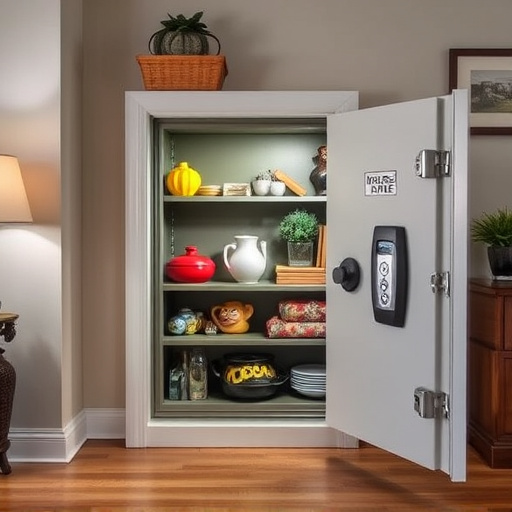Diversion safes for home offer a creative way to secure valuable items by integrating them into everyday objects like books or kitchen appliances, providing discreet storage and enhanced security. These safes blend in with surroundings, making them less obvious targets for thieves. DIY methods allow homeowners to create hidden compartments in various household items, ensuring personal belongings remain protected from prying eyes.
Uncover the intriguing world of hidden compartments—a secret solution for secure storage. This article explores the concept of ‘diversion safes’—discreetly integrating safety and secrecy into everyday items. From bookshelves to kitchen cupboards, learn how ordinary objects can become unexpected repositories for valuables. Discover the benefits of a diversion safe for home security and creativity. We’ll guide you through designing your own, sharing tips and real-life stories of hidden compartments, offering inspiration for both practical and novel applications.
- Understanding Diversion Safes: The Concept and Benefits
- Common Household Items That Can Be Turned into Secret Compartments
- Designing and Hiding Your Own Safe: Tips and Techniques
- Creative Uses and Real-Life Stories of Hidden Compartments in Homes
Understanding Diversion Safes: The Concept and Benefits
Diversion safes for home are a clever and subtle way to secure valuable items or sensitive documents, cleverly integrated into everyday household objects. The concept behind these safes is to offer a discreet storage solution that blends in with your surroundings, providing a sense of security while maintaining an unassuming appearance. They take advantage of the common practice of hiding valuables in plain sight, making them less obvious targets for thieves.
By utilizing diversion safes, homeowners can protect their possessions from theft or damage without significantly altering their living spaces. These safes are designed to look like everyday items like books, fire extinguishers, or even kitchen appliances, allowing them to be placed in various locations throughout the home. This strategic placement adds an extra layer of protection, as potential intruders might overlook these seemingly innocuous objects while searching for more obvious hiding spots.
Common Household Items That Can Be Turned into Secret Compartments
In the quest for creative security solutions, many individuals are discovering hidden potential within everyday household items. These seemingly ordinary objects can be transformed into ingenious diversion safes for home, offering a unique approach to hiding valuables or sensitive documents. From books and boxes to kitchenware and even clothing, the possibilities are vast. For instance, a vintage book with a hollowed-out center can discreetly conceal cash or small gadgets, while a cleverly designed spice jar might reveal a secret compartment for passwords or keys.
The beauty of this method lies in its subtlety; integrating a secret compartment into common household items allows for a level of discretion that traditional safes may lack. This innovative approach not only adds an element of surprise but also provides an extra layer of security, ensuring that personal belongings remain hidden from prying eyes. Whether it’s for precious heirlooms, important paperwork, or simply a place to stash your favorite treats, these diversion safes offer a fun and practical way to protect your possessions.
Designing and Hiding Your Own Safe: Tips and Techniques
Designing your own hidden compartment or safe is an engaging DIY project that can offer a creative solution for discreet storage. The key to successful hiding lies in understanding diversion safes—items designed with hidden compartments, seamlessly blending into everyday objects. Consider transforming common household items like books, plant pots, or even kitchen appliances. For instance, attach a false bottom to a bookshelf or create a hollowed-out pot with a removable lid.
When designing your safe, think about the placement, size, and shape of the compartment. Ensure it’s large enough for your intended contents while remaining discreet. Use materials that match the item’s aesthetic—wooden crates for books, terra cotta pots for plants, or metal cans for kitchenware. The right placement, whether inside a wall, under furniture, or within an existing structure, adds to its secrecy. Additionally, consider incorporating clever locking mechanisms, such as magnetic locks or intricate puzzles, to secure your hidden treasure.
Creative Uses and Real-Life Stories of Hidden Compartments in Homes
In today’s world, where discretion and secrecy are often paramount, hidden compartments in common household items have found novel creative uses. Beyond their traditional role in diversion safes for home, these discreet storage spaces have become integral to individuals seeking secure locations to hide valuable items, personal documents, or even emergency supplies. From bookshelves that double as secret stashes to antique clocks with concealed compartments, the versatility of hidden storage solutions is remarkable.
Real-life stories abound of ingenious individuals who have transformed everyday objects into security havens. Some have incorporated hidden compartments into their furniture, allowing them to conceal assets away from prying eyes. Others have crafted sophisticated locking mechanisms into kitchen cabinets or office supplies, providing a sense of security for sensitive materials. These creative uses not only underscore the importance of discretion but also highlight the ingenuity of those who adapt and repurpose common household items for unconventional storage needs.
In conclusion, the art of integrating hidden compartments within everyday household items offers a unique solution for secure storage and privacy. By utilizing diversion safes, individuals can now safeguard their valuable possessions while maintaining an unassuming exterior. With a bit of creativity and the right techniques, anyone can transform common objects into secret stashes, providing both security and peace of mind in today’s world. These innovative ideas prove that when it comes to securing your belongings, thinking outside the box can lead to surprising results.
